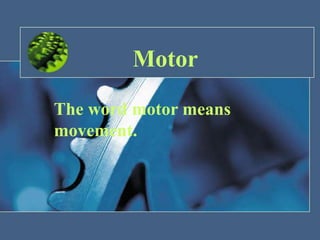
vinay babu.pptx
- 1. Motor The word motor means movement.
- 3. Motor system includes • Tracts eg. Corticospinal (skillful Voluntary movement) Corticobulbar and Bulbospinal (Extrapyramidal) • Basal Ganglia (regulator) • Cerebellum (regulator)
- 4. Types of motor activities • Voluntary movements. • Reflex movements. • Rhythmic motor activity.
- 5. Overview of Motor System Corticospinal tracts Corticobulbar tracts Bulbospinal tracts
- 6. Components of motor neurons • Upper motor neuron (corticospinal & corticobulbar). Starts from motor cortex and ends in 1. Cranial nerve nucleus (corticobulbar). 2. Anterior horn of spinal cord in opposite side(corticospinal tracts). • Lower Motor Neuron Starts from anterior horn of spinal cord and ends in appropriate muscle of the same side. eg. All peripheral motor nerves.
- 8. Levels of motor control • Cerebral cortex • Brain stem • Spinal cord and cranial motor nuclei.
- 9. Cortical Motor Areas Includes 1. Primary Motor Cortex (M-I) 2. Supplementary Motor Area (M-II) 3. Premotor Cortex (PMC) 4. Frontal Eye Field Area 5. Broca’s Area for speech
- 10. Motor cortex • Primary motor cortex ( M1) • Premotor area (PMA) • Supplementary motor area (SMA) Note: All the three projects directly to the spinal cord via corticospinal tract. • Premotor and supplementary motor cortex also project to primary motor cortex and is involved in coordinating & planning complex sequences of movement (motor learning).
- 11. Primary Motor Cortex (M-I) Location :- Immediately anterior to the central sulcus and extends to the medial surface of hemisphere also known as Broadmann’s area 4 is a motor homunculus. Description: Body is represented as up side down and stretched on the medial surface where pelvic and leg muscles are represented. Hand and mouth has a greater area of representation and is large because of frequently used (skill).
- 12. - It controls the musculature of the opposite side of the body. - Face area is bilaterally represented. Functions:- Is used in execution of skilled movements also in codes the direction, force and velocity of movements. Lesions:- Pure M-I lesions are rare. May have contra lateral weakness in distal muscle (fingers). Ability to control fine movements is gone. Ablation of M-I alone cause hypotonia not Spasticity.
- 13. Supplementary Motor Area (M-II) Location: Found on both in lateral and medial aspect of the frontal lobe. It extends from cingulate sulcus on the medial side to reach premotor cortex on the lateral surface of the brain. Function: It works together with premotor cortex. Involved in programming of motor sequences. Lesions: Produces awkwardness in performing complex activity like bimanual coordinated activity.
- 14. It function in mental rehearsal of movements before performing a complex motor functions. With premotor cortex it translates the desire to perform a motor task into a series of motor command that will do the task.
- 15. Premotor Cortex (PMC) Location: Broadmann’s area 6. It lies immediately anterior to primary motor cortex. It is more extensive than primary motor cortex (about 6 times) Functions: It works with the help of basal ganglia, thalamus, primary motor cortex, posterior parietal cortex. It plays role in planning and anticipation of a specific motor act.
- 16. Lesion: It results in re-emergence of suckling and grasp reflex in adults. Its lesion do not case paralysis but only slowing of the complex limb movement. Lesion may result in loss of short-term or working memory. When damaged with supplementary cortex it may result in APRAXIA.
- 17. Corticospinal Tract Origin – Sensory cortex, primary Motor Cortex, premotor & supplementary cortex (40%) (30%) (30%) Internal Capsule Pons Cerebral Peduncle (midbarain) Medullary Pyramid Pyramidal Decussation Lat.Cross & Vent. Uncross White matter in spinal cord Ant. Horn of spinal cord through a interconnection α motor neuron of opposite side
- 18. FUNCTIONS • Controls primarily distal muscle which are finely controlling the skilled movements of thumb & fingers on the opposite side. eg. Painting writing, picking up of a small object etc. Effect of lesion: loss of distal motor function in opposite side. Pure corticospinal tract lesion cause hypotonia instead of spasticity The reason is that pure pyramidal tract lesion is very very rare, and spasticity is due to loss of inhibitory control of extrapyramidal tract.
- 21. Definition: Tracts other than corticospinal tract are known as Extrapyramidal tract. The word extrapyramidal is slowly being replaced by Corticonuclear & corticobulbar tracts.
- 22. Components of extrapyramidal system 1. Basal Ganglia 2. Midbrain giving rise to following bulbospinal tracts. A. Rubrospinal tract. B. Vestibulospinal Tract. C. Reticulospinal Tract D. Tectspinal Tract. E. Olivospinal Tract.
- 23. Overview of Motor System Corticospinal tracts Corticobulbar tracts Bulbospinal tracts
- 24. Reticulospinal Tract The reticular formation makes up a central core through much of the brainstem. It contains many different nuclear groups. Pontine and medullary nuclei projects to the anterior horn of the spinal cord. Functions: influence motor functions as for example voluntary & reflex movement and is also responsible for the muscle tone.
- 25. Olivospinal Tract It arises in the cells of inferior olive of the medulla and is found only in the cervical region of the spinal cord. Function is unknown
- 26. Motor – Sensory Integration